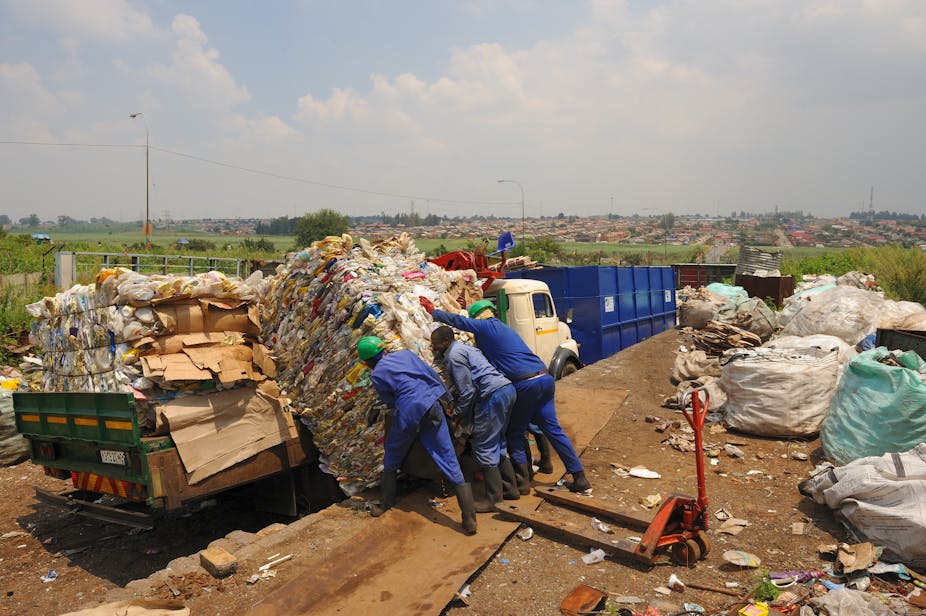There has been considerable public attention in recent years on the role of waste in developing countries, in particular because they are often recipients of waste that originates in developed countries. Certain types of waste, such as scrap metal, are sources of inexpensive raw materials for manufacturing purposes.
The recycling of waste to recover and then reprocess materials into new products, when this doesn’t hurt the environment, can provide economic benefit. The type of economic system that aims to eliminate waste and the continual use of resources, known as a circular economy, can help to reduce the amount of landfill waste and contribute towards sustainable development.
But such aspirations don’t automatically translate into the best outcomes – for people, or for the environment. In the US, research has been done showing that larger recycling sites are located in poor neighbourhoods. And China has severely restricted imports of such waste since 2018, citing problems with soil and material contamination.
In sub-Saharan Africa rapid population growth and economic development have contributed to unprecedented growth in waste and the number of waste sites in the region. This is concerning given that there is considerable scientific evidence about wide-ranging health consequences of living near waste sites. Examples range from asthma to effects on mental health.
There is little country-level evidence in sub-Saharan Africa that quantifies the health risk of living close to a waste site. To fill this knowledge gap, we conducted an investigation in South Africa.
Our research found that between 2008 and 2015 there was a substantial increase in the number of people exposed to waste sites because of a spike in the number of landfill sites. Our findings also identified multiple health risks in living close to waste sites. The study illustrates how poor people are taking on the brunt of the negative effects of waste.
What we found
We used nationally representative data from the South African National Income Dynamics Study. The database is designed to monitor socio-economic factors and the health of households over time. The geographical coordinates of each household are included. We then used waste site geospatial locations from the South African Waste Information System to derive the distance between the nearest waste site and the income dynamics households, in kilometres.
We used these sources of information to get a handle on the growth in the number of waste sites and to quantify the health status of 32,255 individuals between 2008 and 2015.
During the period we observed a substantial increase in the number of waste sites – from 42 in 2008 to 1,086 in 2015. Our calculations show that the distance to the nearest site decreased from 68.3km in 2008 to 8.5km in 2015. In terms of finite distance, 2.8% of homes were within 5km distance of a waste site in 2008. This estimate increased to around 35.5% by 2015.
We also found from our analysis that people living within 5km of a waste site were at a higher risk of certain conditions. We calculated that this population had a 41% higher risk of asthma, an 18% higher risk of developing tuberculosis, a 25% higher chance of having diabetes, and an 8% greater chance of having depression compared to those who lived further than 5km from a waste site.
Equally important, we found that tuberculosis, diabetes and depression were significantly higher among individuals from households with lower income, highlighting health inequalities associated with poverty.
One major study limitation is that we did not have an actual measure of pollutants from waste sites to establish a causality relationship between exposure to waste sites and health. But we also can’t rule out the possibility of reverse causation and association. For example, individuals with poor health and low income don’t have much choice about where they live.
What should be done
A number of steps need to be taken to address the issues we faced.
Firstly, it’s necessary to reduce the amount of waste and number of sites through more aggressive recycling. According to a 2018 report by the South African Department of Environment, Forestry and Fisheries, only 10% of waste is recycled. The remaining estimated 98 million tons is deposited into landfill sites each year.
There also needs to be an improvement in waste management. The choice between economic growth and environmental protection is a false dichotomy, given that the conservation of ecosystem services is in itself a sustainable economic development strategy.
Although doubtful in practice, we acknowledge the point of view that waste and innovations in waste management sites (such as waste-to-energy incineration technology) may be an opportunity for economic activity and counter against climate change if planned and implemented correctly. But do these sites have to be close to where people live, especially the marginalised and socioeconomically vulnerable?
As South Africa advances with its waste management, particularly managing the waste of developed countries, it should ask itself whose interests are being served.

